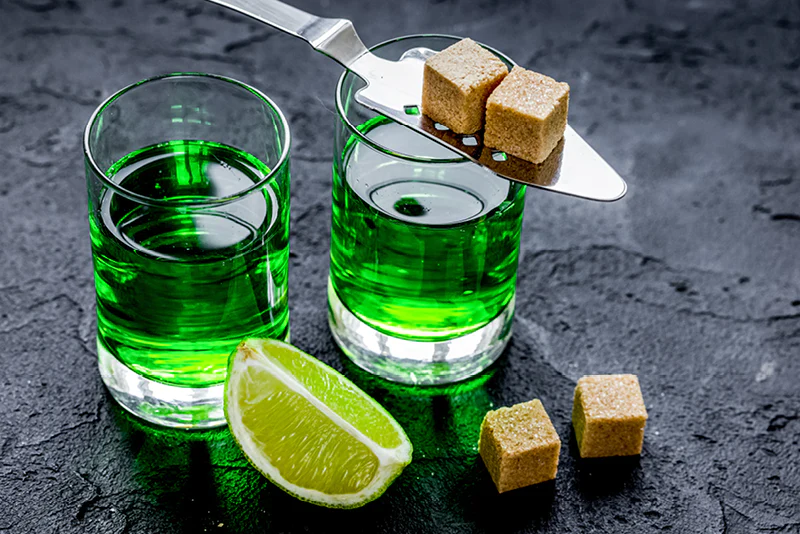As a new generation falls in love with the green fairy, new absinthe brands are popping up all over the world – but which are regarded as the fan favourites?
While native to Europe, the key ingredient found in absinthe is wormwood, and it grows readily across various climates, including parts of Asia, Africa, South America, and the United States. Wormwood is naturally rich in thujone, a chemical compound believed to trigger inexplicable transformations of the mind.

In the 19th century, absinthe often got the blame for what would now be viewed as outright alcoholism, but was nevertheless linked to bouts of mania, psychosis, violent and erratic behaviour. While the wormwood in the liquor was regarded as a stimulant for some, it also acted as a catalyst for a descent into lunacy for others, and eventually led to bans on absinthe right across Europe.
However, absence only tends to make the heart grow fonder, and the notoriety of absinthe only helped to cement it’s status as one of the world’s most infamous liquors. These days, the green elixir is brewed in many distilleries, and is arguably just as in demand as it once was. In saying that, not all absinthe brands are regarded as favourable – so what are a few of our top picks?
THE WORLD’S BEST ABSINTHE BRANDS
While the ‘green fairy’ is more of a well rounded marketing ploy (a la Baz Lurhman) as opposed to an actual health hazard, absinthe still has a reputation for instigating hedonistic tendencies and all round debauchery. However, as it’s still sold on the shelf at anywhere between 45-80% pure alcohol, you’re going to want to pay attention to absinthe brands if you want to get the good stuff and avoid the mother of all headaches.

Pernod Absinthe Superieure – Arguably the godfather of all absinthe brands, the Pernod tipple has well and truly set the benchmark for absinthe production on a global scale. Originally brewed in Marseille as early as 1805, the original recipe was brought back to life in 2013 for the French – and in fact, the world – to embrace and revere once more.

Leopold Bros Absinthe Verte – Paying homage to the traditional roots of absinthe production, Leopold Bros’ version of our favourite elixir has a base of Chilean pisco (grape based spirit) with the addition of fennel, anise seed and grande wormwood. Thanks to the infusion of lemon balm and hyssop, it’s intoxicating green colour is so vibrant that it almost looks fake.

Moulin Rooz – Regarded as the first premium Australian made absinthe, Moulin Rooz is the brainchild of Gold Coast Hinterland producers at the Mount Tamborine Distillery. Winning multiple awards around the world, Moulin Rooz is the green liquor of legends distilled in Queensland with Australian botanical infusions.

La Clandestine – Switzerland was one of many countries to lift its decades old ban on absinthe in the early 2000’s, and Artemisia-Bugnon were one of the first distillers to jump back on the bandwagon of absinthe production. This crystal clear absinthe is based on a 1935 recipe, but contrary to other traditional recipes, the distillers recommend drinking it sans sugar.

St George Absinthe Verte – As soon as the United States lifted the ban on absinthe in 2007, St George Spirits were one of the first to jump on the bandwagon and deliver Americans it’s first home grown – and legal – absinthe. Available in a rather antique looking 200ml bottle, it makes it convenient to add to cocktails by the spoonful.

Vieux Pontarlier – Another French absinthe masterpiece, it took the distillers at Tempus Fugit an eye watering five years to craft this award winning recipe. Vieux Pontarlier is produced using one of the last two remaining traditional absinthe stills in France, and is even based on the facility’s original recipe from the 19th century.

Blues Cat Absinthe – Produced in the United States by the Delaware Phoenix Distillery, this absinthe is the result of a collaboration between an absinthe historian, a herb grower, an artist and a blues musician – what could go wrong? The result is a liquor laced with scents of wormwood, coriander and hyssop, and packs a punch with a whopping 68% alcohol content.
More often than not, consumers tend to underestimate the alcohol content of absinthe, so ease into it with mixers to ensure the liquor is to your taste. Like all alcohol, large amounts of absinthe can be physically quite dangerous. Binge drinking absinthe is ill advised, and can lead to alcohol poisoning.
If you’re ready to party like it’s 1889, you’re ready to try the original French absinthe fountain. This method requires some special apparatus though, so ensure you have the right type of spoons and sugar cubes before you get started. However, if you’re relatively new to drinking absinthe, then it’s generally wise to start slowly and use it in a cocktail, such as New Orleans’ famous Sazerac.
While nobody can say whether you’ll witness Kylie Minogue appear as the green fairy after a few glasses a la Moulin Rouge! – there’s no denying that the controversy and mystique are all a part of absinthe’s appeal, and the global curiosity doesn’t look to be diminishing anytime soon.




